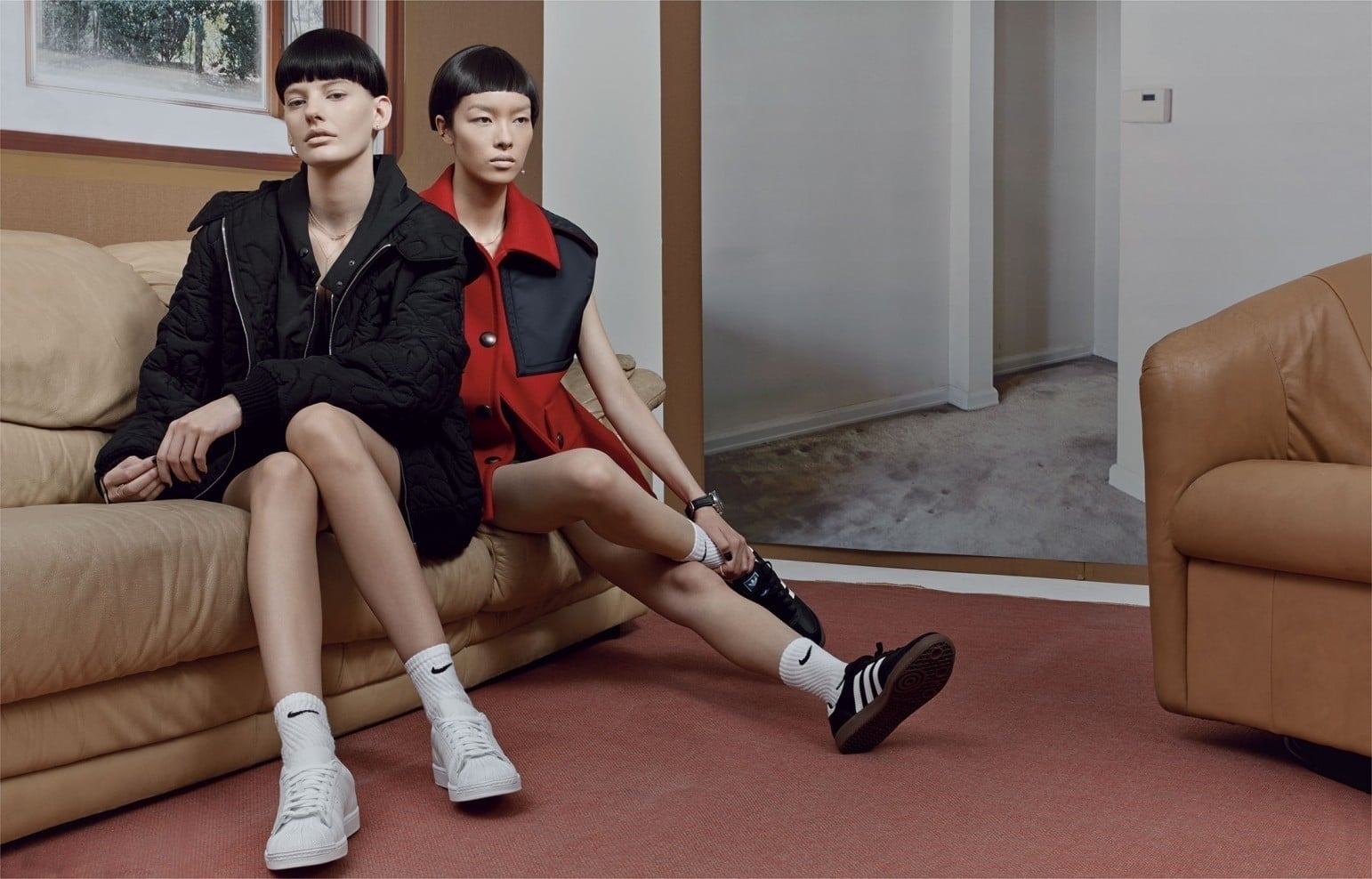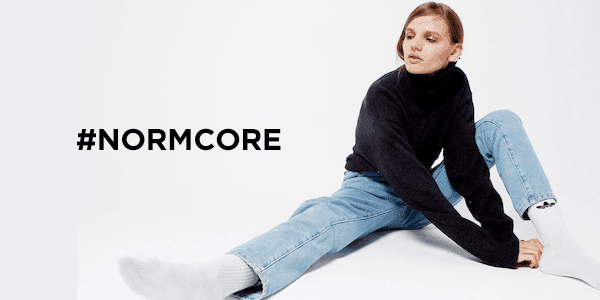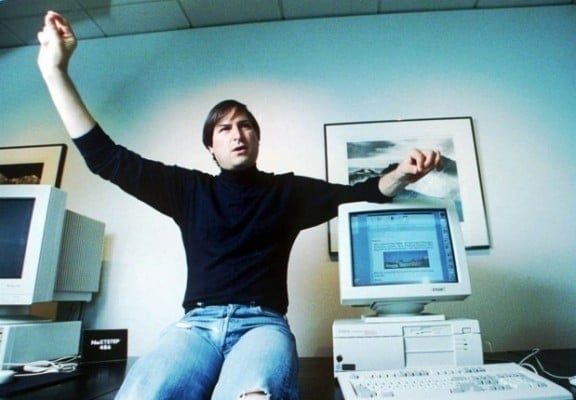November 18, 2015
The Day Fashion Made Us Normal
 Sitting across from Jerry in the iconic New York diner, a balding George dressed in a red polo shirt and light-wash jeans that were standard ’90s fair inquires on the status of the show. Jerry, apparently “has nothing” to show for it. George complains that there is no salsa on the table. A laugh track follows. The conversation continues, back and forth, for minutes until finally, chuckling to himself, George states that “this” should be the show: A show about daily life interactions. A show about nothing.
Sitting across from Jerry in the iconic New York diner, a balding George dressed in a red polo shirt and light-wash jeans that were standard ’90s fair inquires on the status of the show. Jerry, apparently “has nothing” to show for it. George complains that there is no salsa on the table. A laugh track follows. The conversation continues, back and forth, for minutes until finally, chuckling to himself, George states that “this” should be the show: A show about daily life interactions. A show about nothing.
Normcore is a subculture heavily steeped in fashion. Like many such subcultures, it is believed that fashion itself gave rise to the more formal culture mores that come with it, rather than the other way around. It is the not the first such subculture strictly defined by fashion. The Beatnicks or “Beats” of the ’40s were arguably one of the first such fashion trends that created a rich subculture around it. Punk, Grunge, Cybergoth, Industrial and most recently, Healthgoth are some of the other more common trends that fall into the odd fashion subgenre of anti-fashion: Trends that are rich in culture and heavily steeped in fashion, but that espouse in spirit a sense of being against things that both categories are formally in favor of. Normcore falls in a unique place amongst this category. On the outside, it is, well, normal. Distinguished by its indistinguishability, Normcore is defined by dressing in ways that are not only average, but many times simply unflattering: Think a pair of regular fit Wrangler jeans and you’ll get the idea. The clothing is decidedly practical in an ultra-urban way, serving only to fill the need to actually wear clothing, but never really caring too much about one’s appearance. Underneath all that, however, is an interesting ideology that treats normal as the new extreme. In essence, Normcore is lashing out at the extremism of fashion, and is anti-fashion in the way that it portrays its own fashion in an uncaring, basic manner. It neither flatters, nor does it exude some sense of self. It is decidedly average, strikingly so, and complements the wearer only in the sense that it removes their identity entirely. By backlashing against the society of fashion that is normally very high and forward thinking, it becomes anti-fashion and twists normal into a word of revolution and revolt.
The history of Normcore is brief. The TV series “Seinfeld” is believed to have been the first instance of verifiable Normcore and probably influenced the trend a great deal. It wasn’t until around 2010, however, that Normcore as a fashion choice began to really come into its own. Within the last year or so, it has been replaced by the newer, harder and edgier Healthgoth, but for a high fashion trend it had a decent run of about four years…and it continues to influence, perhaps not in haute couture, but most certainly in ready to wear circles. Urban Outfitters, the much loved clothing distributor for hipsters and other chic individuals, often maintains a large selection of Normcore-esque clothing in stock. And, like most fashion trends born out of bucking the system, this indicates one of the hilarities of the trend itself that also make it so attractive simultaneously: By revolting against something, it became a standard. By attempting to become “normal” by definition, it created a new meaning for the word. Today, if one wishes to buy into true Normcore fashion, they better be willing to spend money. Clothing, specially designed to look quite average, is rarely cheaper than $50 per piece. Such is the price of quality, and apparently, is the price of looking officially normal and uninteresting.

This isn’t to pick at the trend, though. The untrained eye often makes slight of the so-called fools that buy into fashion, claiming that a simple t-shirt that mimics exactly the one on the high fashion model can be procured for hundreds of dollars less at the local Goodwill. However, the nuances of fashion are often in very slight details that add up to create a sense of quality: Fashion isn’t really about appearance, so much as it is about quality and hemlines and in the trend of Normcore, this stands out as the defining factor. Take the t-shirt as an example. The shirts you generally buy at mass market stores are often made of heavy fabric mixes that look very unflattering on all body types. To compensate, the shirts are cut longer in the back with the shoulder hem faced further backward. The result is a mimed appearance of form fitting function as the shirt hangs longer around the backside now and artificially clings to the body. In higher fashion circles, though, you rarely find such cuts unless dealing with some very specific types of shirts. Instead, t-shirts are cut inward, collars are wide, the bottom flares and the whole thing is made of a lightweight cotton. The result is a natural fit that hangs upon the body and fits its natural curvatures without becoming too tight or bulging in too many areas. Normcore as a trend allowed designers to bring in greater subtlety in their designs as now they were forced to fabricate normalcy out of fine design. In many ways, Normcore was the fore-runner to modern minimalist fashion, a way to tone it down and bring a bit of elegance to a profession that values “over the top” as a currency. Now, t-shirts were cut straight at the hem with the shoulders thrown forward and the collar lines cut back. This pushed the shirt backwards on the body, creating a slimming, snug fit on the front, but allowing it to billow in the back ever so slightly—thus, simulating an ill-fitting “normal” look without sacrificing the obvious quality of a good fit from the front (this has the added benefit of slimming the wearer ever so slightly, and can add length to the vertically challenged). The end result is Normcore becoming a bit of jazz in the fashion world: A misunderstood trend by those unwilling to take the time to appreciate the nuances therein.
Normcore didn’t survive. Of course, for everyday people of everyday fashion, it survives and thrives: It can take decades for the trickle down nature of fashion to finally weed out a trend and what was high fashion some five, six or ten years ago is only just reaching mainstream stores in some way or another. Ready to wear moves a bit quicker and mimics the high fashion trends in more affordable and socially acceptable ways and here we are already seeing the shift to the darker and sleeker Healthgoth trend set to replace Normcore as the king of youth fashion. Perhaps the most interesting aspect of Normcore, though, is the simple fact that it is completely uninteresting. Outside of fashion-obsessed youth culture, documenting feigned normalcy on the pages of Tumblr, there is never really much to say about Normcore. You wouldn’t find it a fashion magazine and although there was a time when the catwalk displayed it very openly, it didn’t last (the runway is fickle). Of course, the very nature of its documentation is also itself, interesting and decidedly un-normal.
Normcore could very well be the first widespread fashion trend that spread over Tumblr. Now widely regarded as a place to find odd, yet seemingly average, fashion trends ranging from “health” to “witchy”, Tumblr’s fashion incubator was most likely just Normcore. Somewhere along the line, Normcore became more than just normal clothing and the quality mentioned earlier took hold and it became fashion: Normcore was decidedly a “rich kid” trend, and although now it has become more affordable thanks to the ready to wear stores selling fashionable modes of it, it has been able to retain its pivot from rebellious normal to elitist angst: A means of expressing one’s dissatisfaction with their place in society by reaching into the popper’s dish—but looking good while doing so (in fashion, a brand is worth more than anything). This is neither here nor there; it’s just the way of fashion, but I find it unique in this case because of how anti-fashion Normcore really is at heart, yet it was rebranded as being quite fashionable at the height of its maturity. It’s a bit like how futurist artwork was radical and jarring in the 1910s and then the surrealists came along a bit later and proved everyone before them to really be quite sane.

If there ever was a face of Normcore, I’d have to say it was someone completely unrelated to fashion at all—and in fact, ridiculed for his fashion choices entirely: Steve Jobs. Blue jeans, black turtleneck, athletic walking shoes: A man that cared so heavily about design simply could not have cared less about the design of his wardrobe and in doing so, embalmed into history the essence of what Normcore really is all about.
In the end, there doesn’t seem to be much normal about it at all.
Previous post Elaenia: The Fusion Future of Music Ever since the MP3 made music easily accessible, the track has remained king over the once all mighty album. Rarely do listeners take the time sit Next post The Good the Bad and Ugly: A Tribute In 1966, a masterpiece of film was released to the world. It single handedly ushered in a new era of cinema and introduced the world to the